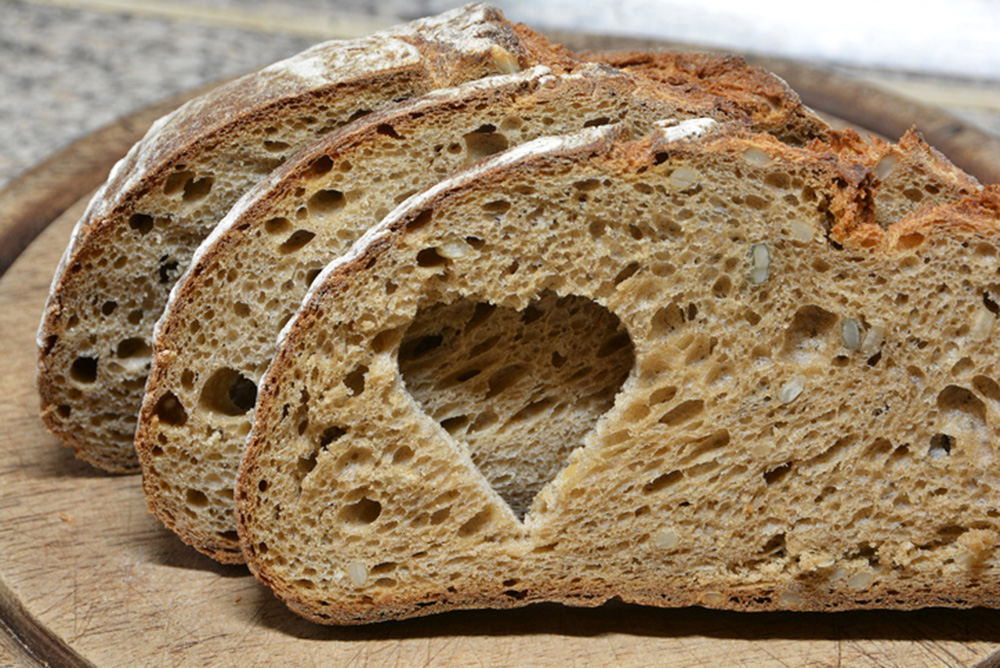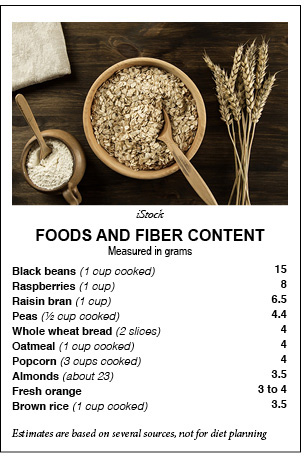
iStock
ON THE LIST of high-fiber foods, raspberries appear to be loaded (one cup provides 8 grams), but raspberries don’t do everything “fiber” is given credit for. As it turns out, not all fiber is created equal.
The best life-prolonging fiber based on clinical evidence is that found in “cereal”—whole wheat bread and pasta, brown rice, seeds, barley and other food containing intact whole grains—for both healthy people and those diagnosed with cancer.
The conclusion: credit should in fact go to the whole grain containing the fiber—and not the fibrous component alone—for contributing to the longest and healthiest life. Accordingly, recommendations from the 2016 federal Dietary Guidelines for Americans advise making whole grains half of all the grains consumed.
 “Whole grain is not the same as fiber, because fiber doesn’t always include the whole grain,” explains Kay Cahill Allison, former editor of Harvard Health.
“Whole grain is not the same as fiber, because fiber doesn’t always include the whole grain,” explains Kay Cahill Allison, former editor of Harvard Health.
Whole grain refers to any grain—corn, rice, wheat, oats, rye—remaining in its natural form, which is comprised of bran, a germ and an endosperm. The latter is all that remains after refining, and bran is simply the high-fiber casing. For packaged food, to be certain it contains the whole grain, one of the first five ingredients on the label should read “whole grain, “whole wheat, “whole grain oats,” etc.
The average American woman gets half of the recommended amount of fiber, which is about 25 g./day for the 50-and-under crowd, and 21 g./day for anyone older. Another formula is 14 grams of fiber for every 1,000 calories consumed (see chart).
Of almost 400,000 people (AARP members ages 50-71) in a 2011 National Cancer Institute Study, controlling for variables like smoking and alcohol intake, those who ate the most fiber over a nine-year period (26 g./day for women) were 22% less likely to die from any cause compared with those who ate the least (11 g./day for women).
The healthiest of all were those who got the most fiber from grains, not from fruit and vegetables. A more recent study that followed 1,575 health professionals diagnosed with colon cancer over eight years also linked fiber from cereal to the greatest decrease in risk of death from cancer and other causes, compared to fiber from other sources.
Fiber refers to indigestible carbohydrates—with different health benefits based on the category of fiber. Cereal fiber, including nuts, whole wheat, grains, brown rice and produce skins, is “insoluble,” meaning unable to blend with water, which allows it to pass through the digestive system mostly intact. Dubbed “nature’s laxative,” insoluble fiber can speed the passage of food and waste through the gut to help prevent constipation.
On the other hand, fruits—berries, bananas, oranges and apples along with oats, legumes and flax—are soluble fibers that blend with water to form a gel-like substance that binds with fatty acids to flush them out, which lowers unhealthy cholesterol. The gel slows digestion, making it take longer for the body to absorb sugar, which helps prevent spikes in blood sugar levels blamed for metabolic conditions like diabetes.
Among the soluble fibers is a further division: the more viscous the fiber, the thicker the gel and the longer it remains in the gut, slowing digestion, creating a longer-lasting feeling of fullness and reducing appetite. The only fiber to reduce food intake and cause weight loss in dozens of studies, viscous fiber is found in legumes, oats, flax seeds and pectins (in fruits, berries and seeds), as well as in asparagus and Brussels sprouts.
A third division puts some fiber in the “fermentable” category, most of which is soluble, including beans and legumes, as well as pectins. This fiber is digested, or fermented, by the gut to be used as fuel for producing more “gut-friendly” bacteria, increasingly considered essential for good health, including weight management, blood-sugar control and mental health and especially for enhancing the immune system’s ability to fight infection.
The downside of fermentable fiber: its notorious gas production.
Although such categorizing of fibers seems to emphasize health benefits of soluble, viscous and fermentable fibers, like raspberries, clinical evidence traces long-term health to the opposite—insoluble, whole-grain cereal fibers—leading to the conclusion that it’s not the fiber.
Instead it’s “the natural package of nutrients that comes with fiber—vitamins, minerals and other phytonutrients ranging from antioxidants to zinc— that protects human tissues from the damage and inflammation common to diseases such as heart disease,” two Harvard Public Health researchers told Allison.
If fiber alone is not the answer, most boxed cereal, in which grains have been stripped of fiber and then “fortified,” is less healthy than a hefty bowl of air-popped corn.
On the other hand, when choosing among whole grains, oats and wheat are generally the healthiest. Whole oats are especially effective in lowering cholesterol, have more protein than wheat or corn, and along with legumes create a feeling of fullness that can help with weight loss. Fullness is also a benefit of whole wheat, as is reduced risk of the metabolic conditions that lead to heart disease and diabetes.
If there was ever a good reason for a cookie diet, recent entries in meal-replacement cookies boast loads of whole grain, along with protein and omega-3 fatty acids. Susie’s Smart Breakfast Cookies, at least the orange, cranberry nut flavor (at DC’s Yes! Organic Markets) list as the first ingredient “whole grain oats” and boast 2000mg of omega-3 fatty acids and 8 grams of protein.
Nutritionists believe that the weight-loss potential of meal-replacement cookies comes from a combination of the fullness created by eating whole grains, the reliability of the number of calories in a cookie-meal (410 in a Smart Cookie) and the satisfaction. Who doesn’t feel better after eating a cookie?
—Mary Carpenter
Learn more about healthy living in our well-being columns.

Thanks for the nice mention, Mary, and the great article! So that’s why people find the Breakfast Cookies so satisfying!
Good advice about fiber, but really — breakfast cookies? One cookie has 22 grams of sugar and not much more fiber than a serving of oatmeal. Seems like there are better choices from among non-processed foods for breakfast.
You are right, of course, about the added sugar. But compared to other foods eaten for breakfast, even high protein, high omega-3 eggs, that have no fiber –- and especially for those on the go — the “cookie” has lots of both, plus fiber.